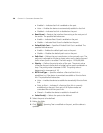13
CONFIGURING QUALITY OF
SERVICE
Quality of Service (QoS) provides the ability to implement QoS and priority
queuing within a network. For example, certain types of traffic that
require minimal delay, such as Voice, Video, and real-time traffic can be
assigned a high priority queue, while other traffic can be assigned a lower
priority queue. The result is an improved traffic flow for traffic with high
demand. QoS is defined by:
■ Classification — Specifies which packet fields are matched to specific
values. All packets matching the user-defined specifications are
classified together.
■ Action — Defines traffic management where packets are forwarded
are based on packet information, and packet field values such as
VLAN Priority Tag (VPT) and DiffServ Code Point (DSCP).
■ VPT Classification Information — VLAN Priority Tags (VPT) are used
to classify packets by mapping packets to one of the egress queues.
VPT to Queue assignments are user-definable. Packets arriving
untagged are assigned a default VPT value, which is set on a per-port
basis. The assigned VPT is used to map the packet to the egress
queue.
This section contains information for configuring QoS, and includes the
following topics:
■ Viewing CoS Settings
■ Defining CoS
■ Viewing CoS to Queue
■ Defining CoS to Queue
■ Viewing DSCP to Queue
■ Configuring DSCP Queue
■ Configuring Trust Settings
■ Viewing Bandwidth Settings
■ Defining Bandwidth Settings
■ Defining Voice VLAN


















